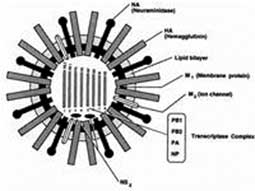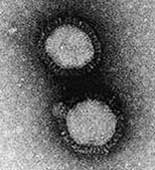 |
|
Structure of Influenza A |
The H5N1 avian influenza virus thrives during the cold season from October to March, which corresponds with the peak activity period of common human influenza strains.
Experts are concerned that the avian influenza virus in humans and birds may “interbreed” within a “mixed host” (meaning it could infect both types of viruses, such as humans or pigs), creating a deadly hybrid capable of easily transmitting from person to person and potentially leading to millions of deaths worldwide.
The question arises: why does the peak of influenza outbreaks often occur during this time of year? Scientists suggest there are numerous explanations, ranging from the virus being more “comfortable” in cooler, humid environments to the fact that people tend to gather during the holiday season, providing conditions for the virus to thrive.
Last year, a group of Asian scientists published in the journal Nature that the H5N1 virus has been active in China since 2001 in a seasonal pattern, with peaks occurring from October to March when average temperatures drop below 20 degrees Celsius. Notably, the lower the temperature, the better the virus survives.
“When temperatures drop below 20 degrees Celsius, the isolation rate of H5N1 increases by 15% in waterfowl,” stated Yuen Kwok-yung, a leading scientist from Hong Kong in the fight against SARS and avian influenza. The isolation rate refers to the amount of virus present in samples such as blood and waste.
Waterfowl are considered a natural reservoir for H5N1, allowing the virus to jump to humans for the first time in Hong Kong in 1997, resulting in six fatalities. Since late 2003, the virus has caused outbreaks in the poultry industry across many Asian countries, leading to at least 62 deaths. In recent weeks, the virus has also appeared in Europe, including Russia, Turkey, and Romania, with many experts attributing this to migrating birds.
 |
|
Influenza Virus Under Microscope |
Samson Wong, a microbiologist from the University of Hong Kong, noted that the avian influenza virus can survive for up to four days in water at around 22 degrees Celsius. At 0 degrees Celsius, they can last more than 30 days. This virus can also survive longer in moist environments on droplets and waste from infected bodies.
Dr. Malik Peiris, also from the University of Hong Kong, stated, “The virus does not reproduce outside of a host. Through soil and fecal contamination, the virus can persist until it can transfer from one entity to another. The strong proliferation of the virus may relate to human density and close contact during the cold season, or movement in enclosed vehicles to keep warm. People also tend to socialize more during the cold season.”
Another reason is the reduction of ultraviolet (UV) rays in winter. According to Alan Hampson, an advisor to the Australian government in pandemic influenza preparedness, UV rays have the ability to inactivate viruses and bacteria. “However, UV rays alone cannot fully explain it. They can only be a contributing factor. Humidity and temperature also determine how long the virus can survive in the environment,” Hampson emphasized.

Mỹ Linh (according to Reuters)


















































